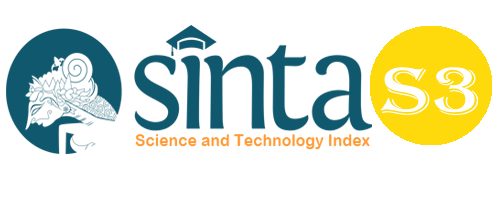Human Resource Management Practice through the Training Needs Assessment (TNA) Approach
Abstract
Human Resource Management Practice in HR management mostly done in profit organizations and rarely done by public organizations. So the purpose of this research is to identify and construct a model of human resource development through a training needs assessment approach in public organizations. The research design used descriptive qualitative, by interviewing 13 informants. The result of the study indicates that: 1) the training needs assessment (TNA) model has not worked well, 2) the potential for operational personnel is not sufficient in supporting the implementation of community service tasks, both in terms of quantity, educational qualifications, skills and abilities possessed. 3) Efforts to develop intellectual capital are quite good, with policies on basic training, special training, salaries and bonuses, promotions, and work safety guarantees, and 4) Intellectual capital development has not fully had a significant impact on improving the performance of operational personnel that can be measured at the level of case handling the achievement is only 81.84%.
Keywords
Full Text:
PDFReferences
Afandi, P. (2016). Concept & Indicator Human Resources Management for Management Research. Deepublish.
Ambar Teguh Sulistiyani dan Rosidah. (2013). Manajemen Sumber Daya Manusia. Graha Ilmu.
Amstrong, M. (2010). Human Resource Management. Great Britain.
Bernardin, H. Jhon and Joyce, E. A. R. (2013). Human Resource Management: Experiential Approach. McGraw Hill.
Blaga, P., & Jozsef, B. (2014). Increasing Human Resource Efficiency in the Production Process. Procedia Technology. Procedia Technology, 469–475. https://doi.org/https://doi.org/10.1016/j.protcy.2013.12.516
Chalofsky, N. E. (2010). Meaningful Workplaces: Reframing Where and How We Work. Jossey-Bass.
Chris Rowley & Keith Jackson. (2012). Manajemen Sumber Daya Manusia The Key Concepts, Cetakan Kesatu. PT Rajagrafindo Persada.
Dahiyah, S. dan A. J. (2011). Training Needs Assessment : A Critical Study. International Journal of Information Technology and Knowledge Management, 4(1), 263–267.
Doyle, S. (2006). The Manager’s Pocket Guide To Training. HRD Press Inc.
Ejere, E. S. I. (2011). Human Capital Formation as Catalyst for National Development: Nigeria in Perspective. International Business and Management, 2(2), 98–104.
Feti Fatimah Maulyan. (2019). Peran Pelatihan Guna Meningkatkan Kualitas Sumber Daya Manusia dan Pengembangan Karir: Theoretical Review. Jurnal Sain Manajemen, 1(1). http://ejurnal.univbsi.id/index.php/jsm/index.
Ibrahim, M. B. H. (2011). Manajemen Sumber Daya Manusia. CV. Perdana Mulya Sarana.
Jusriadi, Edi; Syafaruddin, M. R. (2021). Human Capital Development of Research Staff Through Self Leadership, Team Work Management and Culture Diveristy. Manajemen Ide Dan Inspirasi (MINDS), 8(1), 1–14. https://doi.org/10.24252/minds.v8i1.19316
Jusriadi, Edi, R. rahim. (2019). Human Capital Development. NEM-Pekalongan.
Kaswan, Ade Sadikin, A. (2015). Pengembangan Sumber Daya Manusia: Dari Konsepsi, Pararadigma, dan Fungsi. Alfabeta.
La Ode Sugianto a, Titis Purwaningruma, Chamidah, S. (2020). The Effect of Interpersonal Trust and Need of Achievement on the Lecturer’s Performance (Study at Universitas Muhammadiyah Ponorogo). Ekuilibrium: Jurnal Ilmiah Bidang Ilmu Ekonomi, 15(2), 188–195.
Miles, M. dkk. (2015). Analisis Data Kualitatif. Universitas Indonesia Press.
Niati, D. R., Siregar, Z. M. E., & Prayoga, Y. (2021). The Effect of Training on Work Performance and Career Development: The Role of Motivation as Intervening Variable. Budapest International Research and Critics Institute (BIRCI-Journal): Humanities and Social Sciences, 4(2), 2385–2393. https://doi.org/10.33258/birci.v4i2.1940
R. Sabrina. (2021). Manajemen Sumber Daya Manusia: Unggul, Kreatif, dan Inovatif di Era Revolusi Industri 4.0. Jurnal Ilmiah Manajemen Dan Bisnis, 22(2), 216–222.
Sentosa Bangun. (2016). Efektifitas Pendidikan dan Pelatihan untuk Produktifitas Karyawan. Analisis Ekonomi Utama. Analisis Ekonomi Utama, 10(2), 1978–1474.
Stone, R. J. (2008). Human Resource Management. John Wiley & Sons Inc.
Sulaiman, A. (2020). Analisis Peranan Pendidikan Dan Pelatihan Dalam Peningkatan Kinerja Pegawai. Jurnal Akutanika, 6(1).
Sutrisno, E. (2011). anajemen Sumber Daya Manusia. Edisi Pertama. Kencana Prenada Media Group.
Swanson, R. A. and E. F. H. I. (2009). Foundations of Human Resource Development.Second edition. Berrett-Koehler Publisher, Inc (BK).
Swanson, R. A. and E. F. H. I. (2021). Foundations of Human Resource Development. Berrett- Koehler Publisher, Inc (BK).
Umar Burhan. (2019). SELF EFFICACY, SELF ACTUALIZATION, JOBSATISFACTION,ORGANIZATION CITIZENSHIP BEHAVIOR (OCB) AND THE EFFECT ON EMPLOYEE PERFORMANCE. EKUILIBRIUM : JURNAL ILMIAH BIDANG ILMU EKONOMI, 14(1), 45–57.
Usman, E. J. (2020a). Pengembangan Sumberdaya Manusia Melalui Training Needs Assessment pada kantor Kementerian Agama Kota Makassar. Competitiveness, 9(1).
Usman, E. J. (2020b). Pengembangan Sumberdaya Manusia Melalui Training Needs Assessment pada kantor Kementerian Agama Kota Makassar. Competitiveness, 9(1), 51–60.
Y. Saptiana Oktari. (2020). Upaya Peningkatan Mutu Pelatihan Melalui Analisis Kebutuhan Diklat : Sebuah Studi Literatur. Jurnal AgriWidya, 1(1).
DOI: https://doi.org/10.33258/birci.v5i1.4526
Article Metrics
Abstract view : 109 timesPDF - 43 times
Refbacks
- There are currently no refbacks.

This work is licensed under a Creative Commons Attribution-ShareAlike 4.0 International License.

This work is licensed under a Creative Commons Attribution-ShareAlike 4.0 International License.

_.gif)

















_.gif)



